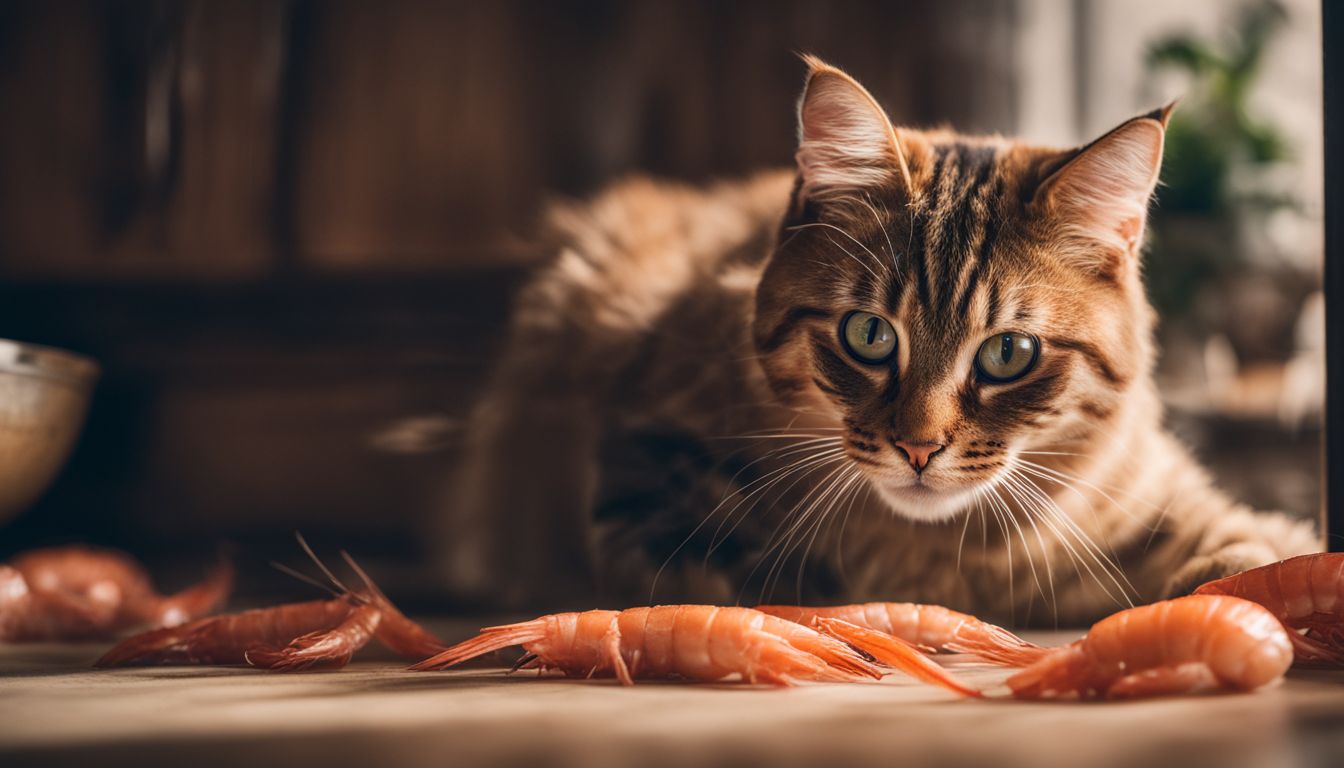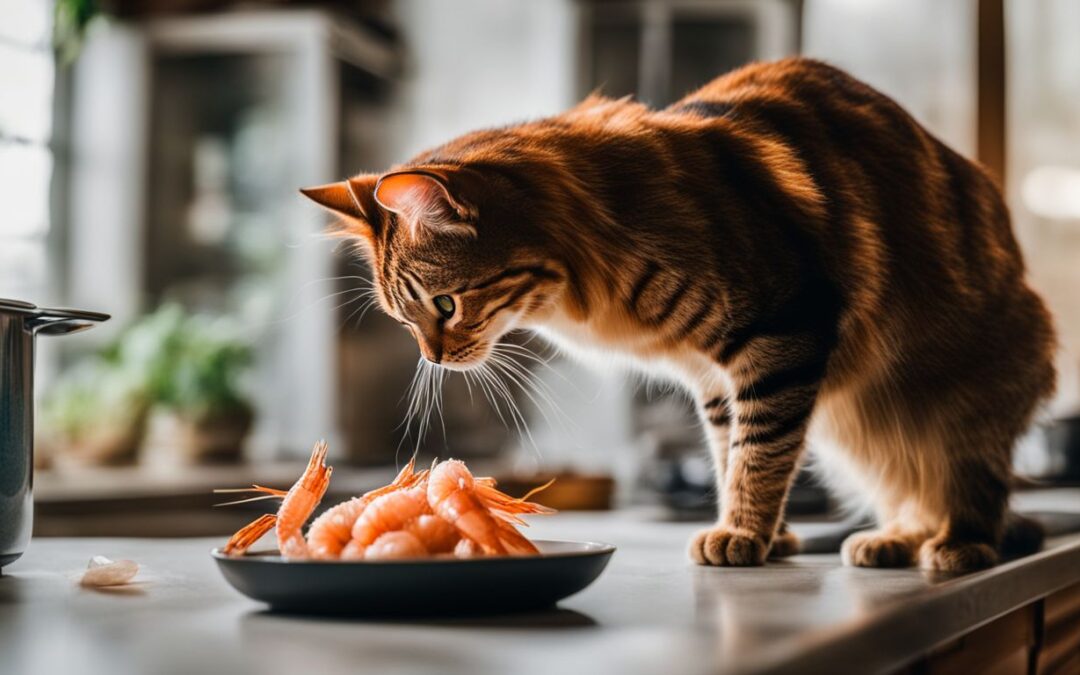Ever found yourself pondering whether your whiskered companion can safely nibble on shrimp tails? You’re not alone in this curiosity! I took it upon myself to scour the depths for answers.
This article aims to illuminate the fascinating blend of benefits, risks, and downright delicious realities surrounding cats and shrimp tails. Brace yourself for a few eye-openers!
Key Takeaways
- Shrimp tails have nutrients like protein, chitin, glucosamine, and chondroitin that are good for cats’ joints and health.
- Feeding cats shrimp tails can cause choking or digestive blockages. It can lead to serious health issues like vomiting, diarrhea, and loss of appetite.
- For safe treats, consider giving your cat small amounts of smoked salmon as an occasional treat but be aware of high sodium levels and preservatives that might not be good for them.
Nutritional Value of Shrimp Tails for Cats

So, I found out something interesting about shrimp tails. They’re like little treasure chests of goodness for cats. These parts are packed with protein and a thing called chitin. Think of chitin as fiber but from the sea world.
It’s in the hard parts of shellfish like shrimp. For us humans, it can help lower cholesterol and make our gut health better. Now, imagine what it does for our furry friends.
Also tucked away in these tails is glucosamine and another buddy called chondroitin. If you’ve ever had joint issues, maybe your doc suggested taking those? Well, they work wonders on joints for cats too, helping them leap and pounce without a care in the world.
In short, adding some shrimp tail to their dish isn’t just about giving them something tasty; it’s packing their meal with nutrients that keep them hopping around happily.
Potential Risks of Feeding Shrimp Tails to Cats

Feeding shrimp tails to cats can pose risks like choking and digestive issues. Ingesting these tails may lead to abdominal pain or even cause blockages in a cat’s digestive system.
Choking Hazard
So, I found out that shrimp tails can really be a bad idea for cats. These parts can get stuck in their throat or even cut their insides. Imagine trying to swallow something sharp and it not going down smoothly.
Ouch, right? That’s what our furry friends might feel. And trust me, seeing your cat choke is scary stuff. You’d need to act fast to help them.
Now, as much as we think these little shrimp end bits are just crunchy leftovers, they’re no good for kitties. They could lead to some serious stomach problems or worse if they cause a blockage inside.
It’s one of those moments when you wish your cat understood the word “no.” But since they don’t, it’s up to us to keep such hazards away from them and stick to safer treat options that won’t end up causing a trip to the vet.
Digestive Issues
Moving on from the scary thought of our furry pals choking, there’s another concern: their tummies might not be happy with shrimp tails either. I found out that these crunchy bits can really mess up a cat’s digestive system.
Picture your fluffy friend eating something that just doesn’t sit right in their stomach—that’s what happens here.
These shrimp parts can cause all sorts of tummy troubles like vomiting and diarrhea, and nobody wants that for their pet. It gets serious pretty fast because they could also lead to blockages.
That means the food can’t move through as it should, and trust me, it’s as bad as it sounds—potentially fatal if we don’t catch it early. Seeing my cat lose her appetite is always a red flag for me; it tells me something is definitely off health-wise.
Signs of Shrimp Tail Ingestion in Cats
Feeding your cat shrimp tails? Here are signs to watch out for:
- Vomiting: If your cat throws up after eating shrimp tails, it might be a sign of digestive issues.
- Diarrhea: Loose or watery stool in cats can indicate an upset stomach from ingesting shrimp tails.
- Loss of Appetite: If your cat suddenly loses interest in food after consuming shrimp tails, it could be a red flag.
Remember these signs when considering treating your feline friend with shrimp tails!
Safe Alternatives for Treating Your Cat
When it comes to treating your cat, there are safe alternatives to consider. To learn more about these options, feel free to explore the full article.
Can Cats Eat Smoked Salmon??
Cats can eat smoked salmon, but it should be in small amounts and as an occasional treat. Smoked salmon is high in sodium which can be harmful to cats if consumed regularly. It also contains a preservative called ethoxyquin, which may not be good for cats.
However, the omega-3 fatty acids in smoked salmon can have health benefits for cats’ skin and coat. Any smoked salmon fed to cats should be plain with no added flavors like garlic or onions.
It’s important that cat owners consider the overall diet of their pets before giving them any human food treats, including smoked salmon. The key things to remember are moderation and ensuring that the smoked salmon does not contain any harmful additives or ingredients for felines.
Conclusion
So, can your furry friend munch on shrimp tails? Well, it’s probably best to steer clear of feeding them shrimp tails. Even though cats are natural-born hunters, they may have trouble digesting the fibrous shells of shrimp.
The potential risks involved – like choking hazards and digestive issues – make it a safer bet to opt for other treats that won’t pose such dangers.
I wouldn’t want my feline companion dealing with an upset tummy or worse just for a little snack. So, when treating your cat, you might want to consider lean meat, cooked fish (minus those bones!), some cat-friendly veggies, or even commercial cat treats.
There are plenty of options out there that won’t put your pet at risk.
Remember to keep an eye out for any signs of discomfort if you do decide to share your meal with your fur baby. And as always – when in doubt about what’s safe for your pet – JustAnswer is here to provide expert advice at your fingertips!
For safe seafood options that your cat can enjoy, check out our guide on whether cats can eat smoked salmon.
FAQs
1. “Can my cat really munch on shrimp tails, or is that a no-go?”
Oh, the great shrimp tail debate! Yes, your kitty can eat cooked shrimp tails in moderation. Just make sure they’re not from raw shrimp to avoid any food poisoning drama. Cooking kills off bad stuff and makes it easier for your furball to digest.
2. “Are there any ‘superpowers’ in shrimp tails for cats?”
You bet! Shrimp tails pack a punch with omega-6 fatty acids, vitamins like B12, and minerals which are all good news for your cat’s health. Think of them as little nutritional boosters – but only as an occasional treat beside their regular cat food.
3. “What about allergies? Could my cat turn into a sneezing mess?”
Just like us humans can get hives from eating something funky, cats might have food sensitivities too. If you notice any allergic reactions (think: itching or stomach upset), hit pause on the shrimp service and chat with your vet.
4. “Do insurance companies cover if my cat gets sick from eating too many shrimp tails?”
Ah, pet insurance… It’s tricky because most policies won’t cover issues caused by foods not meant to be part of a cat’s diet (like excessive amounts of human food). Always check what’s covered under “food allergy” clauses but remember: moderation is key!
5. “I’ve heard something about obesity and feeding my cat shrimps; what’s up with that?”
Shrimp tails are like candy bars for cats – tasty but should not replace their balanced diet due to high fat content which could lead to obesity if overfed. Keep these treats rare and special; think of them as the cherry on top rather than the main meal.
6.”Cooked vs steamed vs raw – how should I serve these shrimpy delights?”
Steaming wins every time! It keeps all those nutrients intact while making sure everything nasty is cooked away without adding fats or oils that cooking might introduce—just plain ol’ steamed goodness ready for nibbling.






